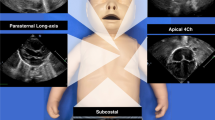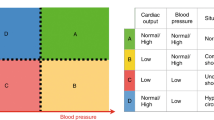Abstract
Shock is a state of circulatory dysfunction and its diagnosis is complex in neonates. Hemodynamic assessment using echocardiography has potential to guide better management regimes in neonates with shock. Objective of this study is to analyze changes in the echocardiographic parameters in preterm neonates with shock at presentation and after resolution. In this prospective pragmatic Cohort study, eligible neonates with shock were monitored for changes in echocardiographic parameters at onset of shock and after resolution of shock. Paired data analysis was done for observed changes in the parameters. Based on initial clinical parameters and echocardiographic parameters, infants were assigned into different types of shock. Data of 37 infants were analyzed for baseline clinical and echocardiographic parameters, and data of 31 infants were analyzed for the changes in the observed parameters after shock resolution. Statistically significant changes were observed in inferior vena cava collapsibility index (ICI), left ventricular end diastolic volume (LVEDV), isovolemic ventricular relaxation time (IVRT), left and right ventricular stroke volume, and ejection fraction (EF). There was no agreement between clinical and echocardiographic definitions of shock.
Conclusion: We noticed shock has overlapping pathophysiologic features. Our study highlights the importance of baseline documentation of echocardiographic parameters of all infants who are at risk of shock and repeat echocardiography at onset of shock to observe the changes in ICI, LVEDV, IVRT, stroke volume, and EF. This would guide pathophysiological management of shock in neonates.
What is Known: • In neonates pathophysiology of shock is overlapping. • Echocardiography can help in better understanding and management of shock. | |
What is New: • Study gives median changes in major echocardiographic parameters in neonatal shock. • These changes can guide for selection of volume and inotropes in management. |


Similar content being viewed by others
Abbreviations
- CRT:
-
Capillary refilling time
- EF:
-
Ejection fraction
- EF1:
-
EF at shock
- EF2:
-
After resolution of shock
- E/A ratio:
-
Mitral valve E wave to A wave ratio
- HR:
-
Heart rate
- ICI:
-
Inferior vena cava collapsibility index
- ICI1:
-
ICI at shock
- ICI2 :
-
ICI after resolution of shock
- IVC:
-
Inferior vena cava
- IVRT:
-
Isovolemic ventricular relaxation time
- IVRT1:
-
IVRT at shock
- IVRT2 :
-
IVRT after resolution of shock
- LSV:
-
Left ventricular stroke volume
- LSV1:
-
LSV at shock
- LSV2 :
-
LSV after resolution of shock
- LVEDV:
-
Left ventricular end diastolic volume
- LVEDV1:
-
LVEDV at shock
- LVEDV2:
-
LVEDV after resolution of shock
- LVO:
-
Left ventricular output
- MAP:
-
Mean arterial pressure
- NICU:
-
Neonatal intensive care unit
- RSV:
-
Right ventricular stroke volume
- RSV1:
-
RSV at shock
- RSV2 :
-
RSV after resolution of shock
- RVO:
-
Right ventricular output
- SVR:
-
Systemic vascular resistance
References
Goldstein B, Giroir B, Randolph A, International Consensus Conference on Pediatric Sepsis (2005) International pediatric sepsis consensus conference: definitions for sepsis and organ dysfunction in pediatrics. Pediatr Crit Care Med J Soc Crit Care Med World Fed Pediatr Intensive Crit Care Soc 6(1):2–8
Giliberti P, Giordano L, Chello G, De Leonibus C, Giliberti P (2010) The scenarios of shock in newborn infants. 23(Suppl 3):27
Sinniah D, Subramaniam T, MyintSoe-Hsiao M (2013) Shock in the neonate. IeJSME 7(2):17–28
de Cássia SR, Clarice G, Soibelmann PR (2010) Sepsis and septic shock in the neonatal period: updating and review of concepts. Rev Bras Tue Intensive. [cited 2020 May 04]; 22(3):280–290. Available at: http://www.scielo.br/scielo.php?script=sci_arttext&pid=S0103-507X2010000300011&lng=pt. https://doi.org/10.1590/S0103-507X2010000300011
Sehgal A, McNamara P (2008) Does point-of-care functional echocardiography enhance cardiovascular care in the NICU? J Perinatol 28:729–735. https://doi.org/10.1038/jp.2008.100
Soleymani S, Borzage M, Seri I (2010 Oct) Hemodynamic monitoring in neonates: advances and challenges. J Perinatol Off J Calif Perinat Assoc. 30(Suppl):S38–S45
Singh Y, Tissot C, Fraga MV, Yousef N, Cortes RG, Lopez J, Sanchez-de-Toledo J, Brierley J, Colunga JM, Raffaj D, da Cruz E, Durand P, Kenderessy P, Lang HJ, Nishisaki A, Kneyber MC, Tissieres P, Conlon TW, de Luca D (2020) International evidence-based guidelines on point of care ultrasound (POCUS) for critically ill neonates and children issued by the POCUS Working Group of the European Society of Paediatric and Neonatal Intensive Care (ESPNIC). Crit Care 24:65. https://doi.org/10.1186/s13054-020-2787-9
de Boode WP, van der Lee R, Horsberg Eriksen B et al (2018) The role of neonatologist performed echocardiography in the assessment and management of neonatal shock. Pediatr Res 84(Suppl 1):57–67. https://doi.org/10.1038/s41390-018-0081-1
Seri I (2001) Neonatal shock: etiology, pathophysiology and management. Prenat Neonatal Med 6. https://doi.org/10.1080/13598630108500263
Saini SS. Hemodynamic changes in preterm neonates with septic shock: a prospective observational study*. - PubMed - NCBI. [cited 2019 Jun 20]. Available from: https://www.ncbi.nlm.nih.gov/pubmed/24717905
Baske K, Saini SS, Dutta S, Sundaram V (2018) Epinephrine versus dopamine in neonatal septic shock: a double-blind randomized controlled trial. Eur J Pediatr 177(9):1335–1342
Deshpande SA, Platt MP (1997) Association between blood lactate and acid-base status and mortality in ventilated babies. Arch Dis Child Fetal Neonatal Ed 76(1):F15–F20. https://doi.org/10.1136/fn.76.1.f15
Ma M, Noori S, Maarek J-M, Holschneider DP, Rubinstein EH, Seri I (2015) Prone positioning decreases cardiac output and increases systemic vascular resistance in neonates. J Perinatol Off J Calif Perinat Assoc 35(6):424–427
Stark MJ, Clifton VL, Wright IMR (2008) Microvascular flow, clinical illness severity and cardiovascular function in the preterm infant. Arch Dis Child Fetal Neonatal Ed 93(4):F271–F274
Walther FJ, Siassi B, King J, Wu PYK (1986) Echocardiographic measurements in normal preterm and term neonates. Acta Paediatr 75(4):563–568
Washio Y, Uchiyama A, Nakanishi H, Totsu S, Masumoto K, Kusuda S (2013 Oct) Hemodynamic analysis in infants with late-onset circulatory collapse. Pediatr Int Off J Jpn Pediatr Soc 55(5):582–588
van Laere D, van Overmeire B, Gupta S, El Khuffash A, Savoia M, McNamara PJ et al (2018) Application of NPE in the assessment of a patent ductus arteriosus. Pediatr Res 84(Suppl 1):46–56
Kieliszczyk J, Baranowski W, Kosiak W (2016) Usefulness of ultrasound examination in the evaluation of a neonate’s body fluid status. J Ultrason 16(65):125–134
Meyer S, Todd D, Shadboldt B (2010) Non-invasive cardiac output monitoring in neonates. Arch Dis Child Fetal Neonatal Ed 95(6):F464–F464
Dannevig I, Dale HC, Liestøl K, Lindemann R (2005) Blood pressure in the neonate: three non-invasive oscillometric pressure monitors compared with invasively measured blood pressure. Acta Paediatr 94:191–196. https://doi.org/10.1111/j.1651-2227.2005.tb01889.x
Werther T, Aichhorn L, Baumgartner S, Berger A, Klebermass-Schrehof K, Salzer-Muhar U (2018) Discrepancy between invasive and non-invasive blood pressure readings in extremely preterm infants in the first four weeks of life. PLoS One 13(12):e0209831. https://doi.org/10.1371/journal.pone.0209831
McLean AS (2016) Echocardiography in shock management. Crit Care 20:275. https://doi.org/10.1186/s13054-016-1401-7
De Backer D, Giglioli S (2020) Echocardiographic approach to shock. J Emerg Crit Care Med [Online], 3 (2019): n.pag. Web. 10 JUL. 2020. https://jeccm.amegroups.com/article/view/5264
Author information
Authors and Affiliations
Contributions
Dr Dinesh Pawale was a Principal Investigator who collected all data, drafted initial manuscript and revised the manuscript. Dr Srinivas Murki conceptualised and designed study, critically reviewed the manuscript and approved the final version of manuscript. Dr Dattatray Kulkarni helped in data collection and manuscript writing. Dr Venkateshwarlu Vardhelli helped in identifying subjects and managment and anlysis of data. Dr Deepak Sharma helped in developing protocol and drafting initial manuscript. Dr Tejopratap Oleti helped in designing study, drafting initial protocol and reviewed final version of manuscript. Dr Sai Kiran coordinated data collection and data analysis and critically reviewed manucript. Dr Shweta Bakhru analysed all stored echocardiograhic data and reviewed final manuscript. Dr Nageswar Rao Koneti reviewed echocardiographic data, helped in drafting intitial manuscript and analysis of data.
Corresponding author
Ethics declarations
Conflict of interest
The authors declare that they have no conflict of interest.
Ethical approval
This article does not contain any studies with human participants or animals performed by any of the authors. Ethics approval obtained from the Institute’s Ethics Committee (Ec Ref No- 25_2017).
Informed consent
Informed consent was obtained from all individual participants included in the study.
Additional information
Communicated by Daniele De Luca
Publisher’s note
Springer Nature remains neutral with regard to jurisdictional claims in published maps and institutional affiliations.
Electronic supplementary material
ESM 1
(DOCX 12 kb)
Rights and permissions
About this article
Cite this article
Pawale, D., Murki, S., Kulkarni, D. et al. Echocardiographic assessment of hemodynamic changes in preterm neonates with shock: a prospective pragmatic cohort study. Eur J Pediatr 179, 1893–1899 (2020). https://doi.org/10.1007/s00431-020-03775-5
Received:
Revised:
Accepted:
Published:
Issue Date:
DOI: https://doi.org/10.1007/s00431-020-03775-5




